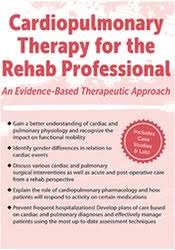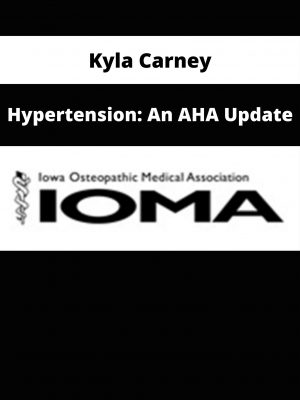Patrick O’Connor – Cardiopulmonary Therapy for the Rehab Professional
$219 Original price was: $219.$62Current price is: $62.
Shopping Instructions:
- DISCOUNT 15% : SHOP15
- Product Delivery: Within 1 – 12 hours after purchase.
In addition, while smoking is trending downward it is still the number one cause of COPD and lung cancer. Rehab and allied health professionals can play a pivotal role in the care of these patients to help reduce length of stay
Patrick O’Connor – Cardiopulmonary Therapy for the Rehab Professional
SYNOPSIS OF CURRENT RESEARCH
- Cardiopulmonary anatomy and physiology
- Fetal and adult cardiac anatomy
EPIDEMIOLOGY OF CARDIOPULMONARY DISEASE
- Impact on community hospitals
- Gender differences in cardiac disease
- Shock states and role of therapy
- Review of current research
CLINICAL ASSESSMENT
- Impact of disease states on functional mobility
- Acute care and post-surgical physical therapy
- 12-Lead EKG
- Cardiopulmonary pharmacology
- What is the impact on rehabilitation?
- Physiological changes and the effects of certain medications
POST-SURGICAL INTERVENTIONS
- Phase II Cardiac Rehabilitation
- Progressing exercise and D/C planning
CASE STUDIES
- COPD
HANDS-ON LAB
- Cardiopulmonary assessment
Would you like to receive Patrick O’Connor – Cardiopulmonary Therapy for the Rehab Professional ?
Description:
Cardiopulmonary Assessment to Manage Your Patients Effectively
Thousands of Americans suffer from cardiopulmonary related diseases which account for a majority of hospitalizations throughout the U.S. Managing those patients adequately can play a critical role in the course of their hospitalizations and can also impact future re-admissions for symptoms related to underlying cardiac and pulmonary illnesses. Even with the increased use of medications to control cholesterol and drug eluding stents, there is still an epidemic of cardiac disease in this country. In addition, while smoking is trending downward it is still the number one cause of COPD and lung cancer. Rehab and allied health professionals can play a pivotal role in the care of these patients to help reduce length of stay, improve functional mobility, and educate patients about the importance of staying active and managing their disease(s) to prevent frequent hospitalizations.
This comprehensive recording will provide valuable clinical information to effectively manage patients with cardiopulmonary issues. You will learn about up-to-date research in cardiac care and be able to identify gender differences in relation to cardiac symptoms. Anatomy, physiology, pharmacology, post-surgical care, and 12-lead EKG interpretation will be discussed and a practical lab component will review auscultation, heart sounds, and assessment techniques for cardiopulmonary patients. Questions related to exercise prescription and progression will also be addressed.
Related products
HEALTH & MEDICAL
HEALTH & MEDICAL
Gaia—Creating-High-Voltage-Health-with-Glenn-Streeter-Open-Minds
HEALTH & MEDICAL
HEALTH & MEDICAL
HEALTH & MEDICAL
Bernadette Giorgi – Attitude Ballet & Pilates Fusion – Just B Method
HEALTH & MEDICAL
HEALTH & MEDICAL
KettleWorX – 8 Week Rapid Evolution Advanced Set with Alex Isaly
HEALTH & MEDICAL












